Leading Lift Companies in London: Providing Exceptional Solution and Support
Leading Lift Companies in London: Providing Exceptional Solution and Support
Blog Article
Looking Into the Globe of Elevators: Typical Concerns Encountered by Numerous Lift Mechanisms
As we browse via the upright transportation systems of modern buildings, lifts stand out as an important component of our daily lives. From hydraulic elevators to traction systems and machine-room-less designs, each lift kind comes with its set of common concerns.
Hydraulic Lifts
Hydraulic elevators, typically preferred for low-rise buildings, use fluid pressure to control the movement of the elevator automobile (lift repair companies). This mechanism involves a hydraulic pump pushing oil into a cyndrical tube, creating the lift to move in the preferred instructions. While hydraulic elevators are known for their peaceful and smooth operation, they do come with their very own collection of common problems
One widespread issue with hydraulic elevators is oil leak. Additionally, problems with the control system, such as defective valves or a malfunctioning pump, can trigger interruptions in the elevator's activity.
Normal maintenance and prompt repair services are vital to make sure the smooth functioning of hydraulic lifts. By dealing with these usual problems proactively, structure proprietors can reduce downtime and make certain the security and efficiency of their vertical transport system.
Traction Lifts
When thinking about vertical transport systems in buildings, another usual type besides hydraulic lifts is the grip elevator. Traction elevators operate utilizing a system of ropes and counterweights that move the lift vehicle by clutching onto the hoist ropes. This mechanism enables for smoother and quicker upright transport contrasted to hydraulic systems.
One of the usual problems dealt with by traction elevators is rope wear. The consistent movement of the ropes within the traction system can cause deterioration in time, potentially creating the elevator to malfunction or become dangerous for usage. Regular evaluations and upkeep of the ropes are important to make certain the lift's correct performance and security.
Another problem that traction lifts may run into is associated with the control system. Issues with the control system can result in concerns such as unpredictable activity, hold-ups in reaction times, or also total shutdowns. Routine testing and maintenance of the control system are important to stop such concerns and make certain the elevator's reliability.
Machine-Room-Less (MRL) Elevators

Among the vital components of MRL elevators is the small gearless grip device that is installed within the hoistway. This equipment efficiently drives the lift auto without the need for cumbersome tools discovered in traditional grip lifts. Furthermore, MRL lifts normally use a counterweight system to balance the car, more improving their energy performance.
Despite their benefits, MRL lifts may face difficulties connected to upkeep and repair service as a result of the constrained room for devices installment. Availability for servicing components within the shaft can be limited, needing specialized training for technicians. Correct maintenance timetables and normal evaluations are vital to ensure the ongoing smooth procedure of MRL elevators.
Overloading and Weight Limit Issues
Are elevators outfitted to deal with excess weight tons effectively and securely? Overloading and weight limit problems are vital problems in lift operations. Elevator producers style lifts with details weight capabilities to guarantee passenger safety and security and devices durability. Get the facts Surpassing these weight limits can lead to numerous troubles, including mechanical failures, delays, and security hazards.
When lifts are overloaded, it puts excessive strain on the electric motor, wires, and other elements, possibly triggering breakdowns or breakdowns. Safety mechanisms such as sensing units and overload sensors are in area to stop elevators from moving if they identify excess weight. In addition, going beyond weight limits can cause increased power intake and damage on the elevator system.
To minimize overloading issues, developing supervisors ought to plainly display weight restrictions in lifts and inform owners on the importance of adhering to these constraints - lift repair companies. Normal maintenance checks by certified service technicians can likewise help make sure that elevators are operating within secure weight criteria. By resolving overloading and weight limit concerns proactively, building owners can improve elevator safety and effectiveness
Electric System Failings
Going beyond weight limitations in lifts can not only result in mechanical concerns however likewise potentially add to electric system failures within the lift infrastructure. Electric system failures are a critical problem in elevator you could try these out operation, as they can cause unexpected shutdowns, breakdowns, and even security dangers. One typical electrical problem is the overheating of components due to extreme present circulation caused by overloading the lift beyond its capacity. This can bring about damage to the wiring, control, or motor systems, leading to expensive repair work and downtime.
In addition, power surges or changes in the electrical supply can also interrupt the lift's procedure, influencing its efficiency and safety and security. These electrical disturbances can harm delicate lift components such as control board, circuit boards, or sensors, leading to system failures. Regular maintenance and inspections are crucial to determine and attend to prospective electrical problems quickly, ensuring the efficient and risk-free procedure of lift systems. By sticking to weight limits and conducting regular electric system checks, structure owners can minimize the danger of electric failings in elevators.
Verdict

Hydraulic elevators, often preferred for low-rise structures, utilize fluid stress to regulate the activity of the elevator automobile.When taking into consideration upright transport systems in structures, another usual type aside from hydraulic lifts is the grip lift. Grip lifts operate utilizing a system of ropes and weights that relocate the lift car by clutching onto the hoist ropes. Unlike traditional elevators that require a separate equipment area to house the equipment, MRL elevators incorporate many of the elements within the shaft, getting rid of the demand for a specialized machine area.In verdict, elevators encounter common problems such as hydraulic malfunctions, traction system failures, and electric system troubles.
Report this page